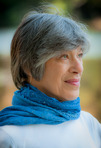Marilyn Oser's Blog, page 5
March 26, 2014
10 Things You Need to Know About…Emile Zola
Journalist, author, man of conscience
 1. Emile Edouard Charles Antoine Zola was born in April 1840 in Paris. He was a French writer, an exemplar of the naturalist school, but this blog will concentrate on the reason why an Israeli street is named for this non-Jew who never set foot in Palestine.
1. Emile Edouard Charles Antoine Zola was born in April 1840 in Paris. He was a French writer, an exemplar of the naturalist school, but this blog will concentrate on the reason why an Israeli street is named for this non-Jew who never set foot in Palestine.
2. Captain Alfred Dreyfus, a French artillery officer, one of the army’s General Staff, was a Jew. When French intelligence discovered evidence of military secrets being smuggled to the Germans, Dreyfus was accused, court-martialed, convicted of treason, and sentenced to life-long penal servitude on Devil’s Island in French Guiana. At the court-martial, Dreyfus was not permitted to examine the evidence against him. A handwriting expert testified that the very lack of resemblance between Dreyfus’ handwriting and the document in question was evidence that he had written it.
3. Dreyfus was publicly humiliated, his insignia torn off and his sword broken in half; he was marched around the parade grounds as the crowd spat at him and cried out “Jew” and “Judas.” Herzl, a young newspaperman at the time, was present, and the experience crystallized his conviction that Jews had no secure home in all of Europe.
4. When evidence emerged that the real culprit was another officer, Ferdinand Esterhazy, a military cover-up ensued. The issue was raised in the French Senate, but the government refused to consider new evidence in the case. Esterhazy was tried, but acquitted.
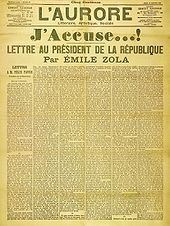 5. Enter Zola. On January 13, 1898, the morning after Esterhazy was acquitted, Zola, who was editor of the newspaper Aurore, risked his career and his freedom by publishing “J’Accuse…!” in bold letters on the front page. In an open letter to the French president Faure, he accused the top levels of the French army of obstruction of justice and anti-Semitism. The letter named names and offered evidence of Dreyfus’ innocence. It accused the handwriting experts of submitting false reports. It accused the courts-martial of violating the law and committing judicial crime. It accused Esterhazy of espionage. Zola wrote, “[Dreyfus] is the victim of…the ‘dirty Jew’ obsession that is the scourge of our time.”
5. Enter Zola. On January 13, 1898, the morning after Esterhazy was acquitted, Zola, who was editor of the newspaper Aurore, risked his career and his freedom by publishing “J’Accuse…!” in bold letters on the front page. In an open letter to the French president Faure, he accused the top levels of the French army of obstruction of justice and anti-Semitism. The letter named names and offered evidence of Dreyfus’ innocence. It accused the handwriting experts of submitting false reports. It accused the courts-martial of violating the law and committing judicial crime. It accused Esterhazy of espionage. Zola wrote, “[Dreyfus] is the victim of…the ‘dirty Jew’ obsession that is the scourge of our time.”
6. Zola’s intention was to be prosecuted for libel so that new evidence could be brought and made public. His letter was to prove the turning point in the case; because of his stature among the intelligentsia, his stand was enormously influential, both in France and abroad. Zola was brought to trial for criminal libel on February 7, 1898, convicted on February 23, and removed from the Legion of Honor.
7. To avoid imprisonment, Zola fled to England, arriving in July of 1898 with only the clothing on his back. A year later, he was offered a pardon – as opposed to exoneration – which he accepted, saying, “The truth is on the march and nothing shall stop it.”
8. Nothing did. In 1899, Dreyfus was returned to France, retried, found guilty and pardoned. Then in 1906, Dreyfus was exonerated by the French Supreme Court. The guilty verdict was annulled; Dreyfus was awarded the Cross of the Legion of Honor as “a soldier who has endured an unparallelled martyrdom.”
9. Zola did not live to see this happy conclusion. He died in September 1902 of carbon monoxide poisoning due to a blocked chimney. Thousands attended his funeral, at which he was eulogized by Anatole France as not just a great man, but “a moment in the human conscience.” Suspicion remains to this day that the blocked chimney was deliberate, a murder by an anti-Dreyfusard.
10. For an excellent article summing up the ins and outs of the case, see Adam Gopnik’s “Trial of the Century: Revisiting the Dreyfus Affair,” published in The New Yorker of September 28, 2009. It should also be noted that in 1998, on the hundredth anniversary of Zola’s statement, France’s Roman Catholic daily, La Croix, apologized for its anti-Semitic articles during the Dreyfus Affair.
In Tel Aviv, you’ll find Emile Zola Street just west of Dizengoff and south of Ben Gurion.








March 19, 2014
12 Things You Need to Know About…Moshe Dayan
Israeli warrior and politician
1. Moshe Dayan was a military leader who played key roles in four wars–and then worked effectively for peace. He was a sabra, born May 1915, the second child born on the first kibbutz to be established in Palestine, Kibbutz Degania Alef, near the shores of Lake Kinneret. His parents were immigrants from Ukraine. They moved to Nahalal, the first moshav, when Dayan was young; he attended agricultural school there.
2. His career as a warrior began in 1929, when he joined the newly formed Haganah at age fourteen to help guard Jewish settlements. During 1936-9, he was with the special police force in the Jezreel Valley and Galilee. In 1938, he joined the Palestine Supernumerary Police, serving under Orde Wingate in the Special Night Squad operations [see my post of March 12]. In October 1939 he was imprisoned in Acre along with other Haganah members, serving a ten-year sentence; all of them were released in 1941 after intervention by Chaim Weizmann. He then served in a small Australian-Palmach-Arab reconnaissance task force, infiltrating Vichy French Lebanon in preparation for an Allied invasion. It was there, in 1941, that he was shot by a sniper who had caught the glint from the binoculars he was using; he lost his eye and extraocular muscles.
 3. Following the war, he made his way quickly up the ladder, appointed to the Haganah general staff in 1947 to work on Arab affairs, including espionage and distribution of abandoned Arab property. In 1948, commanding the Jordan Valley sector, he stopped the Syrian advance. He was first commander of the 89th Battalion, appointed June 1948, and in July of that year became Military Commander of the Jewish-controlled areas of Jerusalem. He was a controversial figure, narrowly escaping court-martial a number of times for disobeying orders. Nonetheless, by October 1949 he was promoted to Major-General and made head of the Southern Command, replacing Yigal Allon [see my post of March 12], much to the dismay of the officers, many of whom resigned. To curb Palestinian infiltration of the borders, he instituted harsh policies, including strafing, raids, mines, and “collective punishment,” against the Arabs by harassing nearby villages and bedouin camps. He considered this policy effective, though not justified or moral. The Arabs were hostile, and he considered terrorism as a stage of war, a way of gaining time while they built up their military strength.
3. Following the war, he made his way quickly up the ladder, appointed to the Haganah general staff in 1947 to work on Arab affairs, including espionage and distribution of abandoned Arab property. In 1948, commanding the Jordan Valley sector, he stopped the Syrian advance. He was first commander of the 89th Battalion, appointed June 1948, and in July of that year became Military Commander of the Jewish-controlled areas of Jerusalem. He was a controversial figure, narrowly escaping court-martial a number of times for disobeying orders. Nonetheless, by October 1949 he was promoted to Major-General and made head of the Southern Command, replacing Yigal Allon [see my post of March 12], much to the dismay of the officers, many of whom resigned. To curb Palestinian infiltration of the borders, he instituted harsh policies, including strafing, raids, mines, and “collective punishment,” against the Arabs by harassing nearby villages and bedouin camps. He considered this policy effective, though not justified or moral. The Arabs were hostile, and he considered terrorism as a stage of war, a way of gaining time while they built up their military strength.
4. In May 1952, after attending a British Army Officer school, he was appointed Operational Commander of the Northern Command; seven months later, Head of Operations (G) Branch, the second-most senior position on the General Staff. A year later, he became Chief of Staff. He reorganized the army, strengthening combat units, revamping mobilization plans, starting a military academy for officers, and emphasizing air force capability. Over the next several years he approved a number of cross-border operations in which civilians were killed. Having carried out operations to instigate an attack by Egypt, in 1956, during the Suez Crisis, he commanded the Israeli forces fighting in the Sinai. He retired from the IDF in 1958.
5. The following year, 1959, he joined the Mapai party and was elected to the Knesset for the first time. He served as Minister of Agriculture from 1959-64. In 1965, with those loyal to Ben-Gurion [see my post of 10/9/13] he formed the Rafi (Alliance of Israel’s Workers) party. He served as Defense Minister (1967-74) and later Foreign Minister (1977-79).
6. During the Six-Day War (1967), he oversaw the capture of East Jerusalem. He was hawkish and did not want to return the occupied territories. A popular hero at that time, he was blamed in 1973 for the ill-preparedness of the IDF at the start of the Yom Kippur War – and for his negative view of Israel’s chance of success following the losses of the first two days.
7. His work as a peacemaker began as early as 1948-9, when he was involved in negotiations with Jordan for a cease-fire in Jerusalem and an armistice; at the same time, though, he urged Ben-Gurion to use the army to open the road to Jerusalem and gain access to the Kotel and Mt. Scopus. As Foreign Minister, he began talks with Egypt in May 1977. The negotiations continued for eighteen months, until finally the Camp
David accords were agreed upon and signed, and the peace agreement with Egypt was a reality. At the end of his life, he advocated unilateral disengagement from the occupied territories.
8. Ariel Sharon said of him,”He would wake up with a hundred ideas….Ninety-five were dangerous; three more had to be rejected; the remaining two, however, were brilliant.”
9. Ambassador Gideon Rafael said of him, “Rocking the boat is his favorite tactic, not to overturn it, but to sway it sufficiently for the helmsman to lose his grip or for some of its unwanted passengers to fall overboard.”
10. His published works include: Diary of the Sinai Campaign, Living With the Bible: A Warrior’s Relationship with the Land of his Forebears, Story of My Life, and “Breakthrough: A Personal Account of the Egypt-Israel Negotiations.
11. Suffering from cancer, he died of a massive heart attack in October 1981 in Tel Aviv. He was buried in Nahalal cemetery.
12. In 2005, Dayan was voted seventy-third on the list of greatest Israelis of all time.
In the Tel Aviv area, you’ll find Moshe Dayyan Street east of, and parallel to, the Ayalon River, and south of Derech HaShalom.








March 12, 2014
12 Things You Need to Know About…Yigal Allon
Israeli warrior and labor Zionist
1. His father had made aliyah in 1890, and he was born Yigal Pelkowitz (or Palcovitch) at Kfar Tavor in the lower Galilee in October 1918. Shortly after graduating from Kadoorie Agricultural High School in 1937, he became one of the founders of Kibbutz Ginosar, also in Galilee.
2. During the Arab revolt of 1936-9, he commanded a field unit of the Haganah and then a mobil patrol. He was part of a hand-picked unit that included Moshe Dayan, working alongside the British in the counter-insurgent Special Night Squads under Captain Orde Wingate, who taught and favored ruthless tactics.
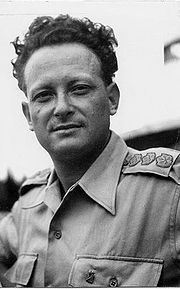 3. World War II broke out. In 1941, Allon became one of the founding members of the Palmach, the elite strike force of the Haganah. In 1941-2, he was a scout with the British forces against the Vichy French in Syria and Lebanon. In 1945, he became Commander-in-Chief of the Palmach. In 1947, he approved an attack on the village of al Khisar in which homes were destroyed and civilians killed.
3. World War II broke out. In 1941, Allon became one of the founding members of the Palmach, the elite strike force of the Haganah. In 1941-2, he was a scout with the British forces against the Vichy French in Syria and Lebanon. In 1945, he became Commander-in-Chief of the Palmach. In 1947, he approved an attack on the village of al Khisar in which homes were destroyed and civilians killed.
4. In June 1948, following the establishment of the State of Israel, he commanded the troops ordered to shell the vessel Altalena in Ben-Gurion’s confrontation with the Irgun.
5. That same year, in the Israeli War of Independence, Allon led several operations on all three fronts – the Galilee, the Center and the Negev – driving out the invading Arab armies and capturing many prisoners of war. He retired from active service in 1950.
6. He studied at the Hebrew University and at St. Anthony’s College, Oxford, reading philosophy and history. He became prominent in the Ahdut HaAvodah (Labor Unity) party and in 1955 was elected for the first time to the Knesset. He was to serve until his death twenty-five years later.
7. He held many prominent portfolios in the cabinets of David Ben-Gurion, Levi Eshkol and Golda Meir. From 1961-7 he served as Minister of Labor; from 1967-9, Deputy Prime Minister and Minister of Immigrant Absorption; interim Prime Minister, briefly, in February-March, 1969; Deputy Prime Minister and Minister of Education and Culture, 1969-74; Minister of Foreign Affairs, 1974-77.
 8. He was the architect of the Allon Plan, a proposal to end the Israeli occupation of the West Bank by negotiated partition of the territories between Israel and the Hashemite Kingdom of Jordan, plus a Druze state on the Golan Heights. The plan was presented to the cabinet in July 1967, at the end of the Six-Day War. It was not accepted by Jordan’s King Hussein.
8. He was the architect of the Allon Plan, a proposal to end the Israeli occupation of the West Bank by negotiated partition of the territories between Israel and the Hashemite Kingdom of Jordan, plus a Druze state on the Golan Heights. The plan was presented to the cabinet in July 1967, at the end of the Six-Day War. It was not accepted by Jordan’s King Hussein.
9. In 1974, he served as a member of the Israeli delegation to the separation-of-forces agreements signed with Egypt and Syria.
10. He was Chairman of the World Labor Zionist movement from 1978-80.
11. He authored Shield of David, 1970, an account of the development of Israel’s defense forces; and My Father’s House, 1975, an autobiography. (He is listed, as well, as the author of The Making of Israel’s Army, 1970, but I believe this to be the British edition of Shield of David.)
12. He died unexpectedly of heart failure in February 1980. His funeral was attended by tens of thousands of mourners. President Yitzhak Navon said in his eulogy that Allon dedicated himself to three matters: Israel’s quest for a just, secure peace with its neighbors; strengthening ties with diaspora Jewry; and finding new paths for Israeli youth. He was buried on the shore of Lake Kinneret in the cemetery of Kibbutz Ginosar, where there is a museum named in his memory.
In Tel Aviv, you’ll find Yigal Allon Street just east of the Ayalon River, running north-south in the vicinity of Derech HaShalom. In Safed you’ll find the Yigal Allon Cultural Center, named in his memory.








March 5, 2014
13 Things You Need to Know About… Baruch Spinoza
Rationalist philosopher
1. He was born Benedito de Espinosa in Amsterdam in November 1632. The son of a successful merchant, he was raised in the Portuguese Sephardic community. He had a traditional Jewish upbringing, but his education was cut short at the age of seventeen, when his elder brother died and he went to work in the family business importing dried fruit.
2. He went on learning. He spoke Portuguese, Hebrew, Spanish and Dutch, and at age twenty began the study of Latin with a freethinking former Jesuit, Franciscus van den Enden, who probably introduced him to modern philosophy. Spinoza evidently taught himself medieval Jewish philosophy, Kabbalah and modern science. In 1654, when his father died, he began teaching at Van den Enden’s school and changed his name to Benedictus de Spinoza. He became friends with dissident Christians who rejected the authority of established churches.
3. After lengthy reflection, he concluded that the scriptures were not authored by Moses and that many prevailing dogmas of Judaism were wrong. In July 1656, at the age of twenty-three, he was exiled from the Jewish community by a cherem for his “evil ideas and acts,” his “abominable heresies” and “monstrous deeds.” Scholars believe he was teaching the ideas that he would soon publish – denying the immortality of the soul; rejecting the notion of a providential god; and claiming that the Law was not given by God.
4. His response to this censure was, “This does not force me to do anything I would not have done of my own accord, had I not been afraid of a scandal.” Attacked on the steps of the synagogue by a knife-wielding assailant, he wore his torn cloak for years afterward as a kind of badge of honor.
5. At about the same time, the importing business turned sour; he turned it over to his younger brother and devoted himself to optics and philosophy. He worked as a lens grinder, a profession that brought him into contact with prominent scientists and mathematicians involving him in optical investigations and the design of microscopes and telescopes. He lived simply, turning down rewards, honors, teaching positions and an inheritance. Though he associated with Christians, he never converted to Christianity.
6. Only two of his works were published in his lifetime: Descartes’ ‘Principles of Philosophy’ and Theologico-Political Treatise. The latter was written in defense of secular and constitutional government, in opposition to the Prince of Orange. It was published anonymously in Hamburg in 1670, but he was quickly identified. One of the prince’s supporters described the tractate as “forged in Hell by a renegade Jew and the Devil.” Spinoza kept writing, but stopped publishing. His other works include A Short Treatise on God, Man and His Well-Being, Treatise on the Improvement of Understanding and his great work, Ethics, which is dense and mathematical. His books were listed on the Catholic Church’s Index of Forbidden Books.
7. Is it any wonder that he wore a signet ring engraved with a rose and the Latin word “caute” (cautiously)?
“Do not weep; do not wax indignant. Understand.” – Spinoza
8. His ideas laid the groundwork for the Enlightenment, modern biblical criticism and modern concepts of the self. In brief, he held that everything that exists is one substance, that God and Nature are two names for this same fundamental substance; that God exists, but is abstract and impersonal, having infinite attributes, some of which are not present in our world; that mind and body, too, are not separate (as Descartes held) but aspects of the same infinite substance; that the reality we experience comes from God, but being the ultimate and only substance, God cannot be prevailed upon by prayer or ritual to change anything.
9. It follows from this that everything that happens, happens of necessity, nothing by chance; that reality is perfection, and that our perception otherwise is because of our inadequate understanding – good and evil are relative and seen with regard to our limited human circumstances. The best human response to the world is to come to understand it better, the highest virtue being knowledge of God/Nature/Universe.
10. Spinoza identified three types of knowledge – opinion, reason and intuition. Intuition, he said, provides the greatest satisfaction; the more conscious we are of ourselves and Nature, the more blessed we are. This line of thought, of course, leads directly to modern psychology.
11. Spinoza’s work appears to have influenced the life, thought and work of many prominent thinkers, including George Eliot (who translated his Ethics into English), Goethe, Maugham, Albert Einstein, Borges and I.B. Singer. Hegel wrote, “You are either a Spinozist or not a philosopher at all.”
12. He died in February 1677 of lung disease, age forty-four, and is buried in the Hague in a Christian cemetery.
13. For more quotations by and about him, see en.wikiquote.org/wiki/Baruch_Spinoza. For more about his philosophy, go to this article by Steven Nadler at http://www.neh.gov/humanities/2013/septemberoctober/feature/why-spinoza-was-excommunicated. A 2008 play, “New Jerusalem” by David Ives is based on the cherem issued against Spinoza.
In Tel Aviv, Spinoza Street runs north-south between Frischmann and Ben Gurion.








February 26, 2014
5 Things You Need to Know About… Oswaldo Aranya
Brazilian Statesman
1. Osvaldo Euclides de Sousa Aranha was born in February 1894, one of eleven children. He was called “Spider,” his mother’s maiden name.
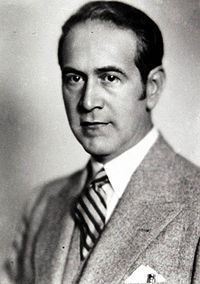 2. He was one of the chief organizers of the 1930 revolution in Brazil and held a number of high positions in the government. From 1933-37 he was ambassador to the United States. But why is he in this blog, and why should you know his name?
2. He was one of the chief organizers of the 1930 revolution in Brazil and held a number of high positions in the government. From 1933-37 he was ambassador to the United States. But why is he in this blog, and why should you know his name?
3. Here’s why: He headed the Brazilian delegation to the United Nations and was President of the General Assembly in 1947. It was he who postponed the vote on the United Nations Partition Plan for Palestine (UNGA 181) for three precious days, giving Harry S. Truman time to call on heads of state and persuade them to vote in its favor. Critical votes were changed and the partition plan adopted. The way was open for a Jewish state.
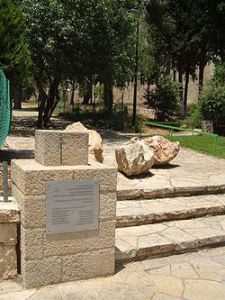
Aranya Square, Jerusalem
4. He died in January 1960. Streets in Beer Sheva and Ramat Gan and a square in Jerusalem are named in his honor.
5. In 2007, Oswaldo Aranya Street in central Tel Aviv was named at a ceremony attended by his relatives and by Brazil’s ambassador to Israel.








February 19, 2014
12 Things You Need to Know About… (Isaac) Adolphe Cremieux
Advocate for the rights of Jews worldwide
1. He was born Isaac Moise Cremieux in Nimes, France, in 1796, to a family that had adopted the revolutionary cause. He was educated at the Lycee Imperial, where he and his cousin were the only Jewish students. In 1817, he was admitted to the bar as a lawyer. His politics were liberal, and he was known for his skillful oratory and broad knowledge of the law.
 2. For a Jew to be admitted to the bar in European courts of law, an oath was required, the More Judaico. This was a humiliating exercise, related to the disavowal of oaths in Kol Nidre. Cremieux refused to take the oath and later, in 1827, defended two others who had refused it – leading to its abolition.
2. For a Jew to be admitted to the bar in European courts of law, an oath was required, the More Judaico. This was a humiliating exercise, related to the disavowal of oaths in Kol Nidre. Cremieux refused to take the oath and later, in 1827, defended two others who had refused it – leading to its abolition.
3. In 1834, he became Vice-President of the Central Consistory of the Jews of France, which administered Jewish affairs. He was to hold this position for 46 years, until his death.
4. In 1840, a blood libel gave rise to the Damascus Affair, in which confessions of the ritual murder of a monk were extracted by torture. Cremieux became part of a delegation to Constantinople that included Moses Montefiore. They succeeded in obtaining recognition of the innocence of the Jews imprisoned in Damascus; release of the nine (out of an original thirteen) still-living prisoners; and a declaration from the Sultan that the accusation of ritual murder was absurd.
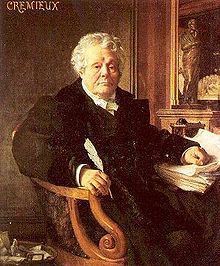 5. In 1842, he entered the Chamber of Deputies; but he took an active role in the 1848 revolution and was imprisoned for a time after it failed.
5. In 1842, he entered the Chamber of Deputies; but he took an active role in the 1848 revolution and was imprisoned for a time after it failed.
6. In 1860, in Paris, he undertook a new strategy for safeguarding the rights of Jews everywhere, as a founder of the Alliance Israelite Universelle. He became its president in 1864, a position he held until his death. The organization’s mission was to free Jews from oppression and discrimination and to defend them wherever they were subject to persecution.
7. This was a high calling, which began with education. The organization opened its first school in Morocco in 1862, to introduce French education and culture to Jews of the Middle East. This strategy – to improve the conditions of Jews in the Middle East through education – has continued down to the present day. Schools were opened throughout the Ottoman Middle East, and teachers were trained to staff them. The organization continues to operate dozens of schools and educational programs in Israel today.
8. An effort was made, as well, to educate the broader public through the press, through pieces on Jewish history and Jewish life. In addition, Cremieux and others worked through friendly governments to exert pressure on those whose laws discriminated against Jews.
9. Cremieux was active in the courts on behalf of Moroccan, Rumanian and Russian Jewry. In St. Petersburg in 1866, he successfully defended the Jews of Saratov against a blood libel. His work created stronger solidarity among Jews of different countries.
10. He re-entered public life in 1869 as a deputy of Paris. In 1870, he proposed and got adopted the Cremieux Decree, which secured full French citizenship for the Jews of Algeria. This was an important moment, but one which had later repercussions: the status of Muslim Arabs and Berbers remained “indigenous,” causing ill feeling.
[image error]
Daumier’s “M. Cremieux seeking an aparment,” 1848
11. Daumier did two lithographs of him, poking fun at his appearance.
12. He died in Paris in 1880 and is buried in Montparnasse Cemetery.
Streets are named for Cremieux in the German Colony in Jerusalem, in central Tel Aviv, and in the French Carmel district of Haifa.








February 12, 2014
11 Things You Need to Know About… the Marmorek Brothers
Zionists
1. This is the story of two brothers, both of them ardent Zionists. Oskar Marmorek is certainly the man for whom Marmorek Street is named, but Alexander is equally worth knowing.
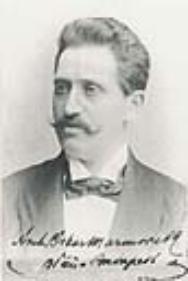
Oskar Marmorek
2. Oskar was born in Galicia in 1863 and trained as an architect. In 1895, he met Theodore Herzl [see my blog post of 6/26/13]. He helped Herzl and Max Nordau [see my blog post of 6/19/13] organize the First World Zionist Congress in 1897, and from then on dedicated himself to Zionism.
3. In May 1901, he traveled with Herzl and David Wolffsohn, Chairman of the Jewish Colonial Trust, to Istanbul to meet with the Sultan in hopes of fostering Jewish life and settlement in Palestine.
4. In 1904, after Herzl’s death, Oskar Marmorek was appointed acting chairman of the World Zionist Organization until the election of David Wolffsohn in 1905.
5. Herzl’s character Dr. Steineck in his book Altneuland is said to be modeled on Oskar – but I wonder whether it was actually his brother, Alexander, a bacteriologist; or even an amalgam of the two. Decide for yourself….
6. Alexander Marmorek was born in Galicia in 1865, two years after Oskar. He was educated at gymnasium and at the University of Vienna, earning his M.D. in 1887. As a student he joined Kadimah, the first students’ Zionist society of Vienna.
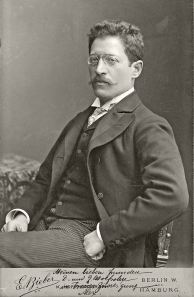
Alexander Marmorek
7. He went to study in Paris and became an assistant at the Pasteur Institute. In 1900, he claimed to have discovered an antidote to puerperal fever, but it proved unsuccessful. However, he did find an antistreptococcus serum that was useful in animals.
8. In 1903, at the French Academy of Medicine, he claimed to have found an antidote for TB. His was one of a long train (at least seven between 1890-1903 alone) of experimental treatments using horse serum that failed because the researchers lacked knowledge of the basic biology of the bacterium.
9. He served as an officer at the first Zionist Congress and succeeding ones. He was head of the French Zionist Federation and founder of the Jewish Popular University in Paris.
10. He was one of the founders of the Parisian Zionist monthly Echo Sioniste. He was decorated with the Legion of Honor.
11. Oskar Marmorek died in Vienna in 1909; his brother Alexander died in Paris in 1923: two brothers, both Zionists, neither of whom made aliyah, both of whom did much to further the vision of a Jewish state.
Marmorek Street can be found in central Tel Aviv intersecting at the spot where Ibn Gevirol becomes Yehuda Halevi Street.








February 5, 2014
10 Things You Need to Know About… Mark Matveyevich Antokolsky
Sculptor
 1. He was born Mordukh Matysovich Antokolski in Vilna in 1840, the last of seven children, to a Jewish family of modest means. As a boy, he drew everywhere, on any surface – table, walls – and did small woodcuts. Though his father thought this an odd occupation, eventually he apprenticed the boy to a wood-cutter.
1. He was born Mordukh Matysovich Antokolski in Vilna in 1840, the last of seven children, to a Jewish family of modest means. As a boy, he drew everywhere, on any surface – table, walls – and did small woodcuts. Though his father thought this an odd occupation, eventually he apprenticed the boy to a wood-cutter.
2. With some help from people of wealth and influence, he was able to study in St. Petersburg as an external student at the Imperial Academy of Arts, 1862-8. His earliest work exhibited Jewish themes, including “Nathan the Wise” and “The Talmudic Debate.”

A Jewish Tailor
3. Predictably, his subjects raised controversy, but nonetheless he met with early success. “A Jewish Tailor” (1864, in wood) won a small silver medal from the Academy. “Stingy Man” (AKA “Jewish Miser” AKA “Miser Counting his Money,” 1865, in ivory) was awarded the Grand Silver Medal.
4. He spent the years 1868-70 in Berlin, in near-poverty, working under difficult conditions. Then his statue of Ivan the Terrible, completed in 1870, was purchased for the Hermitage by Tsar Alexander II. Crowds of people went to view it, and he was awarded the title of Academician by the Academy. “I fell asleep poor, and awoke rich,” he said. “Yesterday I was unknown, but today I’m all the rage.”
5. In poor health, he went to Italy in 1871, and in 1877 settled in Paris. In summers, he frequently returned to Vilna.
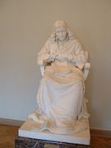
Spinoza
6. He was known for the psychological qualities in his work. His later subjects focused on martyrdom and suffering mankind. He did sculptures of Jesus, Spinoza, Socrates. Noted architect and art critic Vasily Stasov described his work as having “the features of the simple truth, the things that, previously, nobody dared think about in sculpture.”

The sculptor in his studio
7. In Italy, in 1872, he completed a statue of Peter the Great for the Peterhof Palace. Initially, it was poorly received….
8. Then came the Universelle Exposition in Paris, 1878. Antokolsky received the grand prize for an exhibition of his works, including “Peter the Great,” and he was awarded the French Legion of Honor.
9. He died in 1902 and is buried in St. Petersburg in the Jewish section of the Preobazhenskoye Cemetery.
10. A large portion of his work is in the Tretyakov Gallery in Moscow, but several smaller sculptures may be found in the Israel Museum in Jerusalem.
In Tel Aviv, you’ll find Antokolsky Street off Ibn Gevirol, just south of, and parallel to, Arlosoroff.








January 29, 2014
8 Things You Need to Know About…E. M. Lilien
Art nouveau illustrator and printmaker
1. Ephraim Moses Lilien was born in Galicia in 1874.
 2. He attended the Academy of Arts in Cracow from 1889 to -93. In 1896, he won an award for photography (he was mighty good at it – see below) from Jugend, an avant-garde publication.
2. He attended the Academy of Arts in Cracow from 1889 to -93. In 1896, he won an award for photography (he was mighty good at it – see below) from Jugend, an avant-garde publication.
3. In 1902, he was one of the founders of Judische Verlag, the first Jewish-Zionist publisher in Western Europe. Based in Berlin, the company produced artistic and literary works – done by Jews, of course.
4. He was a delegate to the Sixth Zionist Congress in 1903, when the Uganda Plan was first broached.

Lilien’s Self-portrait
5. In the years between 1906 and the First World War, he traveled frequently to Palestine. He was with Boris Schatz in Jerusalem for the establishment of the Bezalel Art School and taught the first class there.

The Silent Song
6. His influence on the establishment of a distinctly Israeli style of art was enormous. He explored Jewish themes, using Biblical subjects in a Zionist context, and incorporating Jewish symbols into art nouveau style. It was thus that he created a visual vocabulary for Zionism.
 7. Reportedly, it is his photograph of Herzl that became THE portrait we know today. He believed that Herzl was the perfect example of the New Jew in the modern world and used Herzl as a model for depictions of Moses.
7. Reportedly, it is his photograph of Herzl that became THE portrait we know today. He believed that Herzl was the perfect example of the New Jew in the modern world and used Herzl as a model for depictions of Moses.
8. He died in Germany in 1925.
In Tel Aviv, you’ll find Lilien Street parallel to Struck just northeast of Rabin Square.








January 22, 2014
9 Things You Need to Know About… Hermann Struck
Artist and Zionist
1. Hermann Struck was born Chaim Aaron ben David to an Orthodox Jewish family in Berlin in March 1876.
2. He attended the Berlin Academy of Fine Arts, completing his studies in 1899. However, despite his artistic excellence, he was not permitted to teach there, because he was Jewish. Was it as a protest against such treatment that he signed his works with his Hebrew name and a Magen David?
 3. In 1904, he joined the Berlin Secession – the modern art movement that had been formed in 1898 as an alternative to the state-run Association of Berlin Artists. He became an artist of world renown, known for his landscapes and portraits, completing commissions for such figures as Ibsen, Nietzsche, Freud, Einstein, Herzl and Oscar Wilde.
3. In 1904, he joined the Berlin Secession – the modern art movement that had been formed in 1898 as an alternative to the state-run Association of Berlin Artists. He became an artist of world renown, known for his landscapes and portraits, completing commissions for such figures as Ibsen, Nietzsche, Freud, Einstein, Herzl and Oscar Wilde.
 4. An accomplished printmaker, in 1908 he published The Art of Etching, a seminal work. Among his students were Marc Chagall, Jacob Steinhardt and Max Liebermann.
4. An accomplished printmaker, in 1908 he published The Art of Etching, a seminal work. Among his students were Marc Chagall, Jacob Steinhardt and Max Liebermann.
5. He was an ardent Zionist. He displayed his artworks at the Fifth Zionist Congress in 1901, and he was a founder of the Mizrachi religious Zionist movement (1902). He visited Palestine for the first time in 1903.
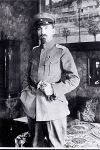 6. During World War I, he served in the German Army as a translator, liaison officer and military artist. He received an Iron Cross class I for bravery and was made an officer. The year 1917 found him on the eastern front serving the German Eastern Front High Command with regard to Jewish affairs. He made aliyah in 1922, settling in Haifa, where he fostered the cultural and artistic life of the city.
6. During World War I, he served in the German Army as a translator, liaison officer and military artist. He received an Iron Cross class I for bravery and was made an officer. The year 1917 found him on the eastern front serving the German Eastern Front High Command with regard to Jewish affairs. He made aliyah in 1922, settling in Haifa, where he fostered the cultural and artistic life of the city.
7. He taught at the Bezalel Academy and helped establish the Tel Aviv Museum of Art.
8. He died in Haifa in January 1944.
9. In 2013, the Hermann Struck Museum (formerly the Struck House) opened in Haifa in the house where Struck lived at 23 Arlosorov Street.
In Tel Aviv, you’ll find Struck Street just east of Ibn Gavirol in the section of artist streets north of Rabin Square.










